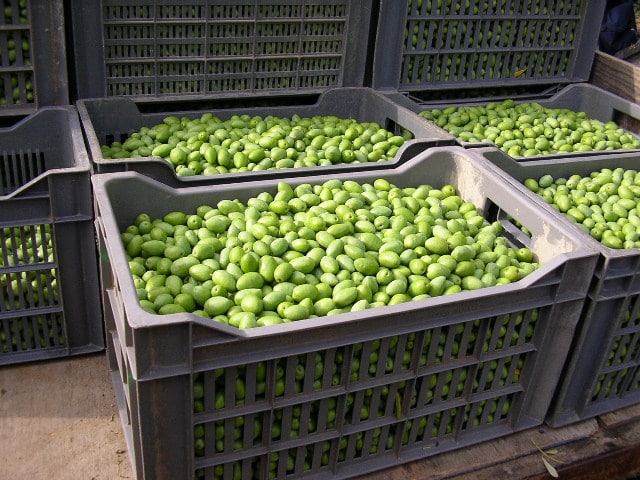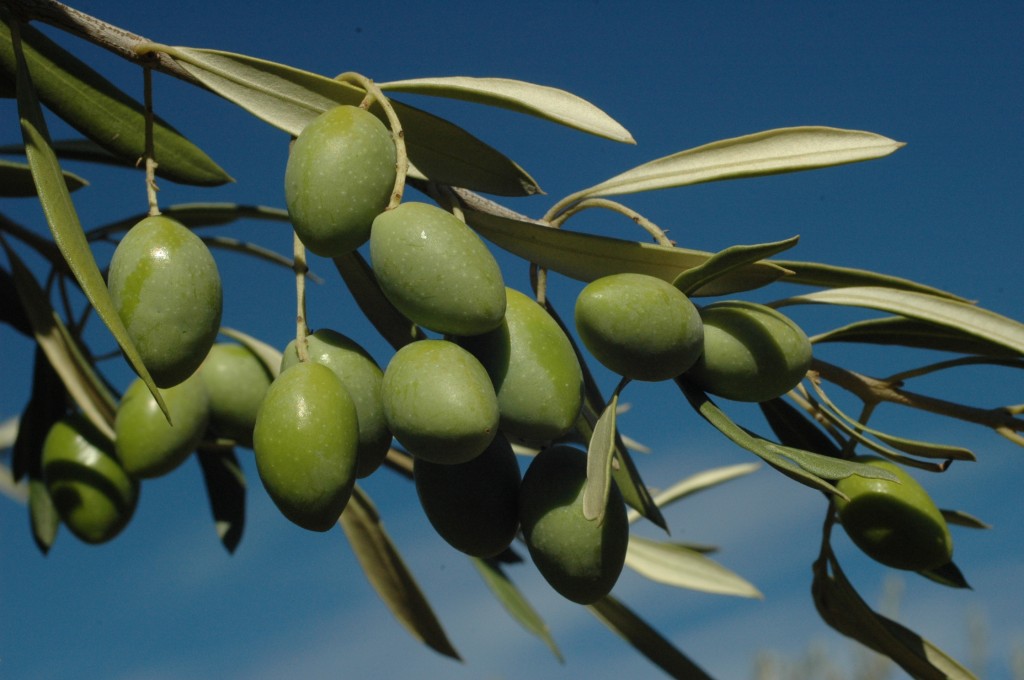The olive confectionery means both the table olive preparation and the company preparing them. The preparation of olives for consumption exists since a long time as Greeks and Romans used them in their meal. Columella (1st century AC) left us very detailed advises about preserved olives preparation which suggests that this practice existed already for a long time and that traditions were settled. Even for an olive variety meant for table olive, all olives don’t suit for olive confectionery, a selection is done. In that way olives which do not meet specific criteria (size, form, ratio pulp/stone, separation of stone and pulp,…) are used for oil production. So this is important to sort its olives before preparation and to push aside damaged olives, too small olives, mouldy olives,…
Preparation
Steps of the preparation of table olives
Sweetening
Olive is the only fruit that can’t be consumed at the harvest even when the fruit is completely ripe it is too bitter and has to be sweetened. The disappearance of bitterness can be obtained by 2 ways :
- by dissolving oleuropein in water
- by dissipation of oleuropein by using a lye solution (soda or potassium). The concentration of lye solution and the time of contact have to be carefully settled for each type of olives (depending on the variety, ripeness…) and depending if we wish to keep some bitterness in the fruit, we have to wait until the solution goes to 2/3 or ¾ of the flesh, or to the stone. Checking the penetration of lye solution is made by naked eye by slicing the fruit halfway down its length. The penetration of lye solution is marked by a darkly colored circle. If the penetration is insufficient, olives are still bitter and do not ferment in the right way while when it is excessive, fruits become soft and can be easily damaged.
The correct progress of the sweetening step allows a better post lactic fermentation and contributes keeping the organoleptic characteristics of olives.

Washing
In case of sweetened olives by soaking in a lye solution, water washings have to be important enough to eliminate the lye solution present in the olive flesh. Washing shouldn’t be too long in order to limit lost in fermentation and mineral substances. Moreover it is good to keep some soda to create an efficient plug system in brine. During washing, in the case of green olive preparation,fruits have to be soaked under water in order to avoid oxidization which could bring the tan, while in the case of black olives, washing should be better done with air contact, that reinforces the color of black olives. Moreover, during all the steps of green olives preparation, it is better to avoid iron containers and tools which could cause the blackening of fruits.
Preservation by fermentation
Lactic fermentation is one of the important steps in the success of table olive preparation. Conditions of growth of lactic bacteria are a salt concentration in brine lower than 8%, pH slightly acidic between 6.2 and 6.5 and a temperature between 20 and 27°C. Lactic fermentation gives to the product a sour savor very appreciated by consumers.

Preparations
Green olives
This is fruits harvested during the ripening cycle, when olives have their normal size but before they turn and when flesh is still firm. In France, the main varieties suitable for this preparation are Picholine, Lucques, Aglandau and Salonenque.
Family preparations :
Green broken olives : first you should slightly break olives with a wooden mallet. Place olives in a recipient and soak them into water. During 9 to 12 days, leave olives into water, change water every day until they lose their bitterness. At this moment, place olives in brine to which you can add coriander, cinnamon, fennel (…) depending on your taste. After 8 days, you can eat your olives. In brine, broken olives can be preserved from 3 to 4 months if covered by brine.
Better use Salonenque or Berugette varieties.
Picholine style : the bitterness of the olives is removed by treating them in a 3-3.5º B (19 to 24 g of soda per liter of water) lye solution in which they are left for 8 to 12 hours until the lye has penetrated three-quarters of the way through the flesh. They are rinsed several times, and then placed in a 5/6% brine solution. After two days, replace the brine by a second in 7% in which olives will stay for 8 to 10 days. Then they are ready to be eaten and conditioned in a brine solution.
Black olives
Fruits are picked at complete ripeness. The most common processes to prepare olives are the immersion in brine and the treatment with dried salt.
Family preparations :
Take black olives, ripe, very smooth (excepted Tanche variety which is always harvested wrinkled).
Preparation in brine : olives have to be soaked in brine (about 10% salt in water) beforehand placed in a glass or earthenware pot. The film that appears on the top has to be pushed aside to air olives. However the film shouldn’t be removed. After 4 to 5 months in brine, olives are ready and can be preserved in this way for 1 or 2 years. For the preserving, low the brine to 80g of salt per liter. To eat black olives, take them out of brine depending on your needs, rinse them and dry them.
Tricks: take olives out some hours before consumption, sprinkle some Provence herbs and pour some olive oil drops.
Some attention on : olives have to be completely soaked into brine not to be oxidized. This method can be used on turning olives.
Better use Grossane, Cailletier, Tanche varieties, …
Cured olives preserved with salt : prick olives on all their surface and roll them into salt to cover them. Leave them in a large basket in a warm and well-ventilated place until they become wrinkled, then dry them, put them into a recipient, salt them again and pour some olive oil drops. Better consume them quickly or freeze. You can also add some Provence herbs before serving.
Better use Grossane or Tanche variety










